So You Hurt Your Back In The Gym?

In This Article We Answer The Questions...
- Is there a "best" treatment for back pain?
- What 3 steps should you take after you hurt your back?
Low back pain (LBP) is the fifth most common reason for all physician visits in the United States and athletes are particiularly at risk (especially certain sports.)
The 2011 study "Treatment Options for Low Back Pain in Athletes" analyzed over 20 treatments for LBP to find the best options for athletes. The conclusion?
To quote the authors:
"Despite the high prevalence of low back pain and the significant burden to the athletes, there are few clearly superior treatment modalities."
Why Traditional Options Don't Work So Well
The study examined the efficacy of several treatment options and found that:
- There is no clear "winner" for fixing back pain
- Most modalities have no evidence they even work (versus simply resting)
The Methods Examined Included:
- Cold vs Heat
- Ultrasound
- Laser
- Steroids
- Non-steroidal anti-inflammatory drugs (NSAIDS)
- Muscle relaxants
- Opiods
- Anti-depressants
- Manipulation: Chiropractic, Osteopathic, Manual Physical Therapy
- Injections
- Acupuncture
- Massage
- Traction
- Transcutaneous electrical nerve stimulation
- Bracing / lumbar supports
- Back schools
- Exercise
The Final Conclusion?
"The treatments available...are broad, but very few treatment modalities have evidence of efficacy."
In my experience the reason that most of these treatments are not very effective is:
- They don't take a systems approach
- Most are based on theory and not experience
- Too much responsibility is put on the therapist to "fix" the patient
Now, to be fair, do any of these methods sometimes help people experiencing back pain?
Absolutely!
Depending on the skill of your doctor or therapist you may find some relief. I know people who have gotten various degrees of success from visiting their chiropractor, physical therapist or acupuncturist...but overall it can be very "hit or miss".
As this 2011 study demonstrates - too many people have been left frustrated and dissatisfied with traditional options and it's time for something better.
Where To Look When Traditional Methods Fail
Science informs traditional methods (and science is great)...but it doesn't always have all the answers. More often than not solutions to problems come from those "in the trenches" rather than those in the lab.

Personally, I've found the most innovative solutions came from unexpected places...
In 2011 I Experienced a Traumatic Back Injury
Recovering from that injury led me on an intensive 5 year journey of self-discovery and self-healing.
I did use some of the traditional methods (chiropractic, massage, etc). However, the most innovative and effective methods I found for fixing my back pain came from:
- A teacher (with 30+ years experience) who was a master at bodywork
- Direct, personal, obsessive exploration and experimentation
The defining feature of these years of study and experimentation was the "test and retest" which was essentially "testing my hypothesis" after every exercise. This meant checking out my range of motion and pain levels after every single exercise to see what kind of change had been made.
In essence, I was running thousands of mini-experiments to see which exercises gave the best return on investment. Eventually this led me to an comprehensive theoretical framework for fixing the back (and any musculoskeletal issue for that matter.)
The TSR Approach
The TSR approach puts the power back in the hands of the patient. It's the "do-it-yourself" approach to fixing back pain that can ultimately lead to you becoming better at fixing your own body than ANY other practitioner could ever be.
It is a synthesis of the "best practices" from traditional methods plus several key tools and exercises that I discovered. These exercises are missing from 99% of the other low back pain treatment protocols out there - and I think they make a REAL difference.
Methods Are Many, Principles Are Few
Here are the PRINCIPLES of successfully fixing your back:
- Targeted Tissue Work
- Progressive Stretching
- Re-Education (motor control and strengthening)
I call this approach the "TSR" method (Tissue Work, Stretching, Re-education)
NOTE: I did not invent the components of this system (stretching, tissue work, motor control training or strength training.) However, I do believe I've found some of the BEST exercises in those areas and put them all together in a unique and effective way.
If you are experiencing back pain, let me share a few helpful exercises that follow the TSR principles.
The following is not an exhaustive list of what will help your back...but it's a damn good start.
Tissue Work
Stretching
Re-Education (Motor Control + Strengthening)
What's The Main Difference of This Approach?
My favorite Bruce Lee quote is: "Absorb what is useful, reject what is useless." The full quote finishes with "... add what is specifically your own."
The exercises in the videos above are a mix of "what was useful" as well as "what is specifically my own."
I've been a coach since 2008 and learned many valuable lessons from "traditional" methods including:
- Yoga
- Physical Therapy
- Chiropractic
- Stretching (PNF, Gymnastics, Ballet, Wushu, Kung-fu, etc)
- Massage (Rolfing, A.R.T, Trigger Point Therapy, etc)
- Acupuncture
- Egoscue
- Strength & Conditioning
However, they also didn't teach me several of the MOST important lessons that I've ever learned.
The one-and-only way of learning these lessons is by extensive trial and error. That's it.
It's something that can't be learned in a book.
There's just no beating direct, personal experience!
Science is great but...more often than not solutions to problems come from those "in the trenches" rather than those in the lab.
For example...along my journey of spending 2-3 hours per day "tinkering" on my body...I started to intuitively understand that if I wriggled and vibrated my body in a certain way...there was a "relaxation response" that allowed my body to drop deeper into a stretch or tissue exercise.
These kind of subtle "learnings" can only be stumbled upon after countless iterations of exercises practiced on the yoga mat or on the gym floor.
My invitation to you is to start your own personal journey to gain deep, experiential knowledge of your own body. For far too long we've depended on other people to fix our bodies. It's time we took that power back!
Will This Work for Chronic Back Pain
Yes. The body is magic at healing itself...if you create the proper conditions.
Starting a systematic recovery plan based on the "TSR" principles will certainly help. The main thing to know is that it takes time.
If you are $50,000 in credit card debt, it will take you longer to pay it off than $5,000. Similarly, chronic back pain may take a while longer to fix than acute back pain. There will be many lessons and lifestyle changes that one must learn to completely "pay off all the debt."
Can I Do This At Home?
Most of the tissue work, stretching and re-education can be done at home. However, there are many useful exercises involving gym equipment (kettlebells, barbells, etc.)
Approximately 80% of the exercises can be done at home, and the remaining 20% when you are able to make it to the gym.
Fixing Athletic Low Back Pain...Step-by-Step
Now that you have the principles for fixing back pain, the only thing left to do is start your own journey. To help, I've also created a step-by-step "do-it-yourself" program for athletes.
It's called "The Athletes Back" and you can get a FREE SNEAK PREVIEW HERE.
You can also get the FULL program HERE.
To a healthy back...for life!
About the Author:
 '
'
Shane Dowd is a sports performance and mobility coach. He specializes in flexibility and injury prevention in athletes.










